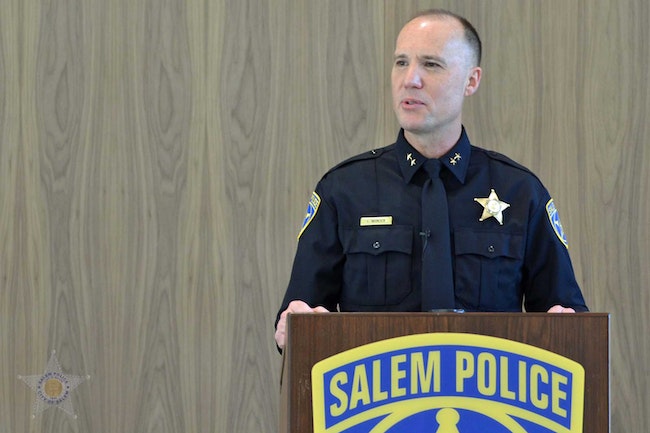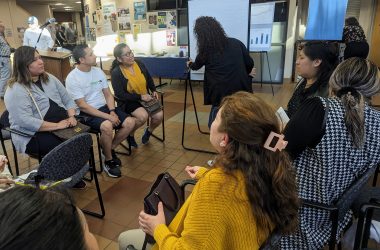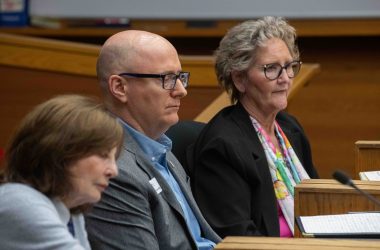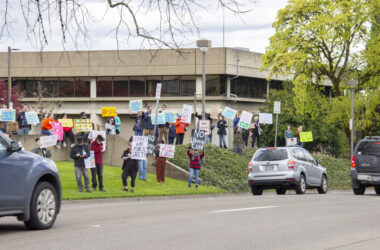Salem officials are looking to put more police in neighborhoods where they can address theft and get to know residents and business owners.
The plan to make it happen includes another ask for taxpayers: that they dig a little deeper into their pockets to fund around 15 more officers.
The request comes as the Salem Police Department can’t hire enough officers with the money it already has. As of May 10, the agency had 22 open jobs for sworn officers, including nine positions added in recent years to improve patrol coverage in the city.
Despite the vacancies, Police Chief Trevor Womack is seeking to expand the budget and employ even more officers, part of a longer-term plan to place new community engagement teams throughout the city who would get to know neighborhoods beyond short-term call response.
If fulfilled, his latest request to city leaders would continue a pattern of ever-increasing city spending on police protection.
Between 2012 and 2022, the population of Salem increased by 14%, while the department’s general fund costs increased by 53%, from $32.96 million to $50.48 million. In 2022, the department employed 249 people.
Womack said that in that time, the additional police staffing did not match pace with population growth. In that decade, the department added 11 positions.
“You go back to 2008, we’ve added 26,000 people, so just to stay at the same ratio, that would say you needed 26 cops. We didn’t add 26 cops, matter of fact we added nine in the last couple budget cycles that we haven’t filled yet,” he said. “So we’re trying to catch up with this deep hole that we’re already in.”
“Our intention is to fill every vacancy. Whether we’ll be able to accomplish that or not, we’ll see.”
–Salem Police Chief Trevor Womack
City leaders want to tax workers an average of $25 per month and raise city utility fees as part of a citywide revenue plan that would fund 15 new police officers.
The plan comes as the city is facing a budget crisis and the police department’s budget has been growing for years.
Womack said the new officers are needed to address property crime and expand the department’s community engagement work, which has suffered as more staff move to patrol positions and emergency response.
Salem’s violent crime rate has been climbing for the past 15 years, according to data the police department released in March, up 42% from 2008. That’s been driven by an increase in assaults, police data shows.
Between 2018 and 2023, the police department received around $2.4 million more from the general fund each year, and saw a budget increase of 28% over five years. In that time, the department added 15 budgeted positions.
If added, the new officers would focus on community engagement with residents and business owners downtown, an expansion of the existing bicycle team. Womack said the department’s growth has failed to keep pace with the city’s population growth and inflation, calling the situation “death by 1,000 cuts.”
He said adding additional officers is key to implementing his community policing plan, which would put teams in neighborhoods where they could work with citizens and business owners and develop long-term solutions beyond responding to calls.
“Then you have enough resources to really do preventative work and intervention work,” Womack told Salem Reporter.
City leaders say the revenue plan is needed to prevent city funds from running out in the next few years. It includes a 60% increase in the city operations fee within the budget that the Salem City Council will consider in July.
If approved, the fee would add $5.50 per month to residential homes, $4.40 per month for multi-family units and $26.51 for industrial, institutional and commercial properties. The city already increased that rate in January 2022 and again last January.
That fee increase would fund three new police officers, and bring the total capacity to 200 sworn officers, which Womack said are needed to maintain current service.
Mayor Chris Hoy said that he hopes the chief will be able to implement the community policing model as promised.
“We’re seeing some violent crimes that are making a lot of people rightfully uncomfortable,” Hoy said. “I think that a community policing model is the way to help turn that around and get it back to where people can feel safe again.”
A payroll tax would likely go to voters in November, though the city council must vote to put the tax on the ballot. If voters approve, the police department would receive $10.5 million per year, about half the funds generated.
The tax would allocate $7 million to the department to sustain current operations, $1.5 million to fund and expand the homeless outreach team, and add an additional $2 million to hire 12 or 13 officers for a community policing program focused downtown.
Payroll tax funds would also be used to fund additional firefighters at a cost of $6.5 million and could pay for the ongoing operation of the city’s newly-opened homeless navigation center and micro shelter sites.
The Salem Police Department is short between 27 and 83 staff, according to an October 2021 police staffing study by audit by Jensen Hughes, a consulting firm. The department hopes to add 60 officers in the coming years.
The study found that patrol officers are spread between multiple roles, and has “adversely impacted its ability to increase outreach efforts to the (Black, Indigenous and people of color) community and collaborate effectively with other entities to address the unsheltered population.”
The department had 22 vacancies in sworn positions within the department as of May 3, including nine positions added during recent budget cycles that remain unfilled.
Womack said that understaffing in the offices makes it more difficult to recruit.
During the May 3 budget meeting, he called recruiting issues “a temporary issue,” that he expects to last two or three years, attributed to nationwide challenges including difficulty retaining officers and lower interest in the career.
He said during the meeting that the department plans to improve recruitment and double its hiring rate.
“Our intention is to fill every vacancy. Whether we’ll be able to accomplish that or not, we’ll see,” he said during the meeting.
Funding for unfilled positions is made available for recruitment or temporary personnel within the police department, or rolls over into the next year.
The police department has converted several part-time community service officer positions into full-time positions, partly using funding from vacant positions. Womack said he also wants to add a police records technician, paid for with vacancy savings.
The department also brought on four employyees for IT and records requests to support its use of body cameras, which started in February.
During a May 3 budget committee meeting, members discussed cutting unfilled positions, a budget move used in state government. City Manager Keith Stahley said the city is not looking into that approach.
“Absolutely not. Our objective is to fill all of the vacancies and expand our services. Cutting is contrary to that,” Stahley said. “We’ve got two problems in the city: one is the revenue problem, the other is a staffing problem. Obviously, they’re related but we are understaffed and under-revenued. And cutting staff is not the solution to increasing revenue or to increasing staffing.”
Womack did not have a deadline for when the new positions would be filled, but said projections show there will be between nine and 12 employees leaving the department each year. He’s set a goal of hiring 20 people a year to address that loss, and to grow the staff.
“It’s an imperfect science. It’s hard to commit to a timeline on that,” he said.
The department hired 15 people last year, and sees an average of 12 hirings per year.
Capt. Kyle Kennedy, spokesman for Oregon State Police, said law enforcement hiring is challenging statewide now, but Salem is in a better position to hire officers than larger agencies like Portland or the state police.
Backlogs in offering classes and certifying officers at the state Department of Public Safety Standards and Training have contributed to hiring challenges, but Kennedy said it’s easier for a smaller agency like Salem to get a few officers into a class. Salem is large enough that it’s attractive to officers who want to keep busy on the job.
“That draws people in. People get in and they want to be active,” he said.
City leaders are contemplating three payroll tax levels, 0.49%, 0.57% or 0.66%, which would cost a Salem worker making the city’s median income of $29.90 an hour between $25.39 and $34.20 a month.
If approved by voters, the payroll tax would show up on paychecks starting January 2025.
A payroll tax was selected because it would meet the revenue need for the city, and would not require going to the voters every five years like a levy would, Stahley said. The tax also broadens who is getting taxed beyond property owners, by including people who work in Salem but live outside city limits.
The payroll tax and increased operations fee were first suggested by the budget committee in 2018, Chief Financial Officer Josh Eggleston said, along with the gas tax for transportation services. The payroll tax was planned for a vote in April 2020, but the council pulled it when the Covid pandemic hit.
Eggleston said increased costs for the police department include wages, retirement, and vehicle costs.
The 2021 police staffing study recommended several options for increased efficiency, which Womack says have been implemented, including changes in staff structure and shift schedules.
In January, the department shifted its patrol officers from 10 hour shifts to a more efficient 12 hour shift schedule. The majority are on two 12 hour shifts, with some on eight hours to provide overlap, Womack said.
The department also no longer sends officers to noise complaints, about 240 calls per year, and is looking to update and expand its online reporting system. An updated system would allow the department to receive more reports without sending an officer to the scene.
The study also recommended reducing the number of calls two officers respond to when only one officer is needed, though it said in general the department is using its resources effectively to serve Salem.
Womack said that the department had efficiency strategies in place to address that.
“So they were really getting down to nitty-gritty: ‘maybe go further with your non-response to alarms, maybe you can cut some other small mobile calls out,’” he said.
Womack said time to engage with the community has gone down, as has their ability to respond to property crime.
“You can live in one area of the city, and the biggest thing is package theft off your porch and mail theft. You can live in another side of the city and you’re having bullets coming through your wall. Two different experiences around safety in our community, both worthwhile, but we’re necessarily having to divert towards violent crime at the expense of property crime,” he said.
If the additional dozen officers are approved, Womack hopes to add officers to the community action unit, who is focused on patrolling downtown on bikes and engaging with businesses. He said over the years, that team has been dispersed to other duties such as violent crime or communication.
“They’re just being spread out over the city. And eventually, if we don’t add, that team will get absorbed into patrol,” he said.
In the years to come, with a goal of 60 more officers, he wants a team similar to the downtown one in each of the six districts in the city, in addition to supporting emergency response, investigations and traffic follow-ups.
Stahley said it’s accurate to say that fire and police were prioritized when it came to increasing and maintaining staffing levels.
“Our objective in the budget is to start with our core services and work out from there. When I started this process, I was looking at ‘how can we enhance our community, safety and security?’” he said.
The proposed budget includes an additional $5 million to add two code enforcement officers, two park rangers and expand the Salem Outreach and Livability Services Team to seven-day-a-week operations from its current five.
Stahley said those additions aim to support the police department, too.
“So we started there with the operations fee, and then looking longer term at the payroll tax said ‘okay, police and fire, how do we maintain them going forward,” he said. “If the operations fee and the payroll tax are not approved, then we will reassess our entire staffing plan.”
Stahley said that he knows that the additional tax is not an easy ask to Salem workers and residents.
“Providing services to our community is not free. And We’d have to make choices about those services and how we pay for them. And there are no easy decisions. There’s no ‘okay, we could just not do that,’” he said. “Just like your cost of living continues to go up, so does our cost of providing those services.”
“There’s no way to mitigate the impact,” Eggleston added. “There’s either an impact on your pay stub or an impact on the services you receive.”
The city’s budget committee meets Wednesday, May 10, to continue to discuss the proposed budget, which includes funding for three additional positions. The meeting will be in-person at 6 p.m. in the council chambers, 555 Liberty St. S.E. and streamed on Capital Community Media’s YouTube channel in English and Spanish.
The committee will likely meet again on May 17 before sending a recommendation to the city council, who have a May 15 work session on the topic and will hold a public meeting about the budget on June 12.
Plans for referring a payroll tax to voters would be discussed at a later date.
Contact reporter Abbey McDonald: [email protected] or 503-704-0355.
SUBSCRIBE TO GET SALEM NEWS – We report on your community with care and depth, fairness and accuracy. Get local news that matters to you. Subscribe today to get our daily newsletters and more. Click I want to subscribe!
Abbey McDonald joined the Salem Reporter in 2022. She previously worked as the business reporter at The Astorian, where she covered labor issues, health care and social services. A University of Oregon grad, she has also reported for the Malheur Enterprise, The News-Review and Willamette Week.









